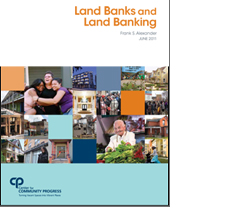Research
July 20, 2011
Helping communities deal with foreclosed, vacant properties


Land banks are a key tool in foreclosure crisis, says housing expert Frank Alexander (top), author of "Land Banks and Land Banking."
Communities across the country are facing unprecedented numbers of vacant and abandoned properties due to the foreclosure crisis, but Emory housing law expert Frank S. Alexander says these empty lots and unoccupied buildings hold the potential for fueling economic recovery, driving community development and strengthening real estate markets.
Alexander's new book, "Land Banks and Land Banking," offers public officials and community leaders a step-by-step guide for taking control of problem properties and leveraging them to spur smart development and meet community needs.
"This new volume was produced as part of the work of the Center for Community Progress, a national not-for-profit entity which my colleague Dan Kildee and I co-founded in 2009," says the Sam Nunn Professor of Law.
His first book on land bank authorities, written in 2005, is considered the field's seminal text. Alexander says, "This new volume is far more than a new edition; it is a new volume detailing the substantial increase in land banks and land banking across the country over the last decade and the parallel increase in the rise of vacant, abandoned and foreclosed properties in virtually every community in the United States."
Alexander says that land banks—public authorities created to efficiently acquire, hold, manage and develop tax-foreclosed property—have emerged as a key tool for urban planners, especially in response to the mortgage crisis. Land banks give communities control of the unused land resources within their borders, he says, which can then create "opportunities for new development when the private market says it isn't possible."
"It is not enough to create a strong program of boarding up properties," says Alexander. "A new set of tools is needed to deal with large-scale vacancies and abandonment."
Land banks must be "created locally, designed locally and managed locally in order for the property that is coming into the land bank to be consistent with the problems facing the community," he explains.
And while vacant and abandoned properties are a nationwide problem, there are distinct differences among communities. "Detroit's inventory may be 30,000-40,000 properties," Alexander notes, "but it's a different kind of inventory than Miami's inventory of condominiums, or Charlotte, North Carolina's inventory of partially built subdivisions, or Stockton, California's inventory of multi-family units."
When Alexander's original book was published, there were just a handful of land banks across the country, concentrated in cities with large inventories of tax-delinquent properties.
Today there are 79 land banking initiatives across the country, with a number of additional land banking bills up for consideration in state legislatures, including Georgia.
"Land banks and land banking were first expressly authorized by federal law in 2008 as part of the federal response to the foreclosure crisis and the creation of the Neighborhood Stabilization Program," he says. "A specific example of the impact of the book is that the New York legislature approved the New York Land Bank Act just two weeks ago, and it is now awaiting Governor Cuomo's signature. That legislation is based substantially on what appears in the book. Parallel legislation is pending in Pennsylvania and in Georgia."
